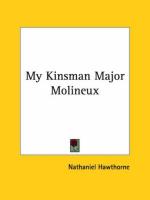|
This section contains 3,372 words (approx. 9 pages at 400 words per page) |

|
In the following essay, Russell looks at Hawthorne's use of allegory within "My Kinsman, Major Molineux."
At five-year intervals, beginning in 1954, Professor Roy Harvey Pearce has encouraged Hawthorne critics to descend with the writer into history rather than pull away and judge his tales in psychological contexts where history is not given first importance. He has brought "My Kinsman, Major Molineux" forward as his chief example because of a recent, almost exclusive concentration on Robin, his dreamexperience, and the initiation rites the boy apparently goes through. One of the contributors to that criticism, Seymour Gross, later summed it up rather interestingly by referring to an American Imago article written by a psychiatrist. This specialist felt that Robin at the end of the story was about to regressto return to his woodsand as Gross remarks, "The psychiatrist stands alone; in the dozen or so other interpretations...
|
This section contains 3,372 words (approx. 9 pages at 400 words per page) |

|




